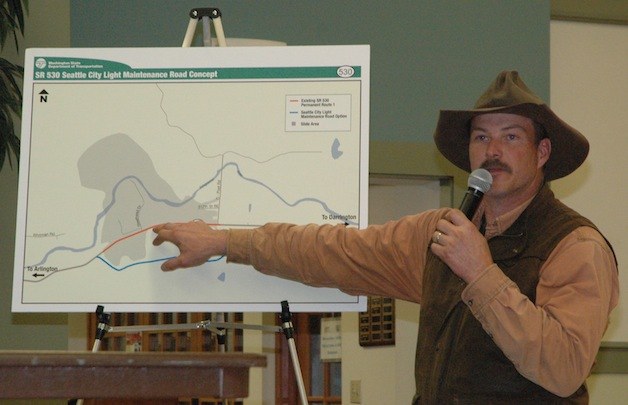SMOKEY POINT — Snohomish County and Washington State Department of Transportation officials answered questions and responded to the concerns of citizens during a Wednesday, April 16, community meeting on how their agencies plan to deal with the wake of the Oso mudslide.
WSDOT Chief Construction Engineer Linea Laird introduced Snohomish County Public Works Director Steve Thomsen, the latter of whom explained how recovery crews were focusing more on the east side of the slide, and working their way up from the south toward the northern end, thanks in no small part to the temporary berms put in place by the Army Corps of Engineers a few days before which allowed searchers to go over terrain that had been too flooded to enter before.
WSDOT Assistant Regional Manager Todd Harrison and Region Administrator Lorena Eng elaborated on the traffic situation, with Harrison acknowledging that Darrington needs at least some form of limited access as soon as possible, while Eng warned that progress toward a full reopening of State Route 530 would be slow-going.
One short-term solution, that Harrison alluded to, is a plan to provide one-lane traffic, flowing in one direction at a time and alternating directions every half-hour, during daylight hours for local traffic access, but as he admitted, “We’re still nailing down the details.”
Eng anticipates that simply sifting through the debris field could last one to three more months, simply because of the human remains that are still expected to be found within the slide itself, “which we want to treat respectfully.” As such, she hopes to see a minimum of one-lane traffic restored on State Route 530 by this fall.
“If it takes until the fall, Darrington is not going to survive,” area resident Dave McGlothern said. “That mill is vital, and truckers can’t be going the long way around for that long.”
The questions came from the crowd before the speakers had even finished their prepared remarks, as Thomsen reassured attendees that an overwhelming response from the community has left Darrington with no shortage of food. Harrison freely conceded that they still need to work out how to provide local traffic access to those who own property in the slide area, but who don’t list those addresses on their IDs, as well as those who have been contracted to work on that property by the owners.
Thomsen was met with objections from several owners of property in the slide zone when he predicted that the majority of the 5 million cubic yards of soil that had been displaced by the slide would not be removed.
“The sheer volume is too much, and there’s no funding source,” Thomsen said. “This is the largest event Snohomish County has ever seen.”
When homeowners pointed out that those with contaminated soil on their lands would be stuck without a way to use their property or sell it off, Laird hastened to note that these issues have barely even begun to be considered by the agencies involved since they’ve been so busy responding to the more immediate impacts of the slide.
Given the similar slide that area experienced in 2006, questions were raised about whether homeowners who came to the area after 2006 were warned of the area’s history. Thomsen asserted that the county sent out notifications to its residents for a variety of potential hazards on their properties, from earthquakes to flooding. However, Davis Hargrave, a former resident of Steelhead Drive in Oso, reported a far different experience.
“I was told nothing,” Hargrave said.







